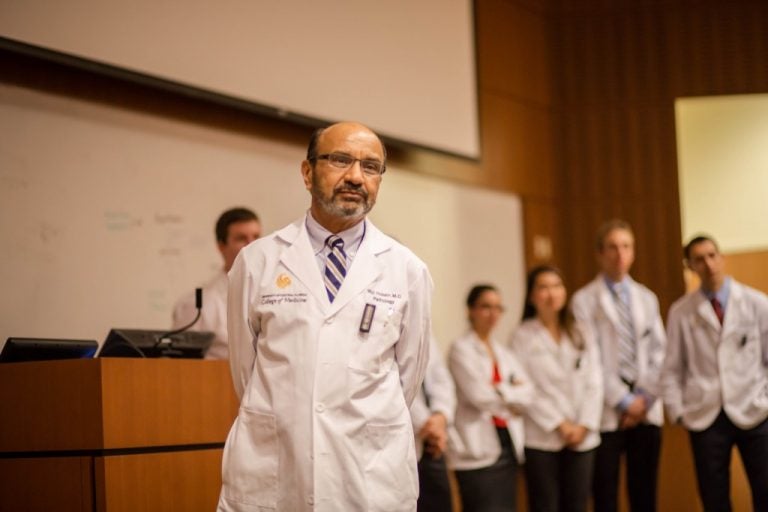The answers to life and death often lie under the magnification of a high-powered microscope and UCF College of Medicine pathology professor Dr. Mujtaba Husain’s specialty is using cells to diagnose disease. In addition, he has joined Dr. Andrew Payer to help create a unique Anatomy Lab curriculum at the medical school, where first-year medical students act as detectives to determine the cause of death of their first patient, a cadaver. Dr. Husain also practices what he teaches. Faced with health issues related to a sedentary lifestyle, he took up running and is now a mountain climber.
Why did you decide to become a doctor specializing in pathology – the branch of medicine that deals with the laboratory examination of tissues to diagnose disease?
I’m a visual person. I want to find out why, why a patient gets sick. In medicine there are a lot of areas of gray. Physicians who enter pathology are always analyzing whys and hows. We like to find answers.
Your subspecialty is cellular pathology, specifically the HPV virus that is a chief cause of cervical cancer. Why?
Most traditional pathologists sit in a room behind a microscope. But I love education. My clients are physicians and educating them about HPV is a big part of my life. HPV occurs in very young women and it doesn’t always lead to precancerous conditions or cancer. But over-treatment of young women is very common and can lead to serious complications like infertility and premature delivery. My job is to work with physicians to examine the pathology and make the best decision for the patient and above all to do no harm.
Anatomy Lab is a rite of passage for first-year medical students. How is UCF’s lab different from traditional medical schools?
In a traditional medical school, you do dissection to learn the structures of the body – where the muscles, bones and internal organs are and how they relate to each other. If students find something abnormal, you don’t worry about it because the focus is on the normal. So anatomy is taught in siloes. At UCF, we bring clinicians into the anatomy lab – neurosurgeons, neurologists, primary care doctors, emergency physicians – so students can see the clinical applications of what they’re learning and understand the clinical effects of abnormalities.
Is that more meaningful to students?
Yes. Basic science is traditionally very boring. You read books and go to lab and students can’t wait to get into their third year and deal with real clinical situations. At UCF, students see clinical relevance from day one.
What happens if students find an abnormality during dissection?
That leads to more inquiry. We talk about why it’s abnormal. We discuss whether to biopsy our finding. Then I go over the biopsy slide with the students and we discuss why the cell is abnormal and what that means for the patient’s health. There is plenty of time for discussion and individual learning. Our goal is to create in students a spirit of inquiry.
You walk the talk in terms of health. How did you get involved in fitness?
Seven years ago, I went to my physician and I was overweight, my blood pressure was creeping up and my cholesterol was high. My physician said, “I think it’s time for you to start taking care of yourself. And the best way to do that is to exercise first and then watch your diet.” I was pretty pessimistic. I didn’t know if I had the willingness and motivation to change.
So what did you do?
I was at the Wayne State University School of Medicine and my office was about a half mile from the medical school. I made a vow that I would never walk – I would always run between the two locations. No matter the weather. Rain, show, whatever. My office was on the ninth floor. So I vowed I would never use the elevator. I would only take the steps.
And that led to running?
In 2009, the University of Michigan sponsored a fundraising race and my wife said I should enter. I didn’t know if I could even finish. But I got a medal in my age group. After that, I started a running regimen and I’ve been running ever since.
You run up and down the stairs at the College of Medicine with a backpack. Why?
I decided to diversify my exercise. My colleague, Dr. Martin Klapheke, is a mountain climber and last year he said, “Why don’t we go to Iceland?” So I started preparing for mountain climbing. I started running the steps on weekends with my 15-pound pack. I did fine in Iceland so now several of the College of Medicine faculty are going to climb Machu Picchu in Peru.
How do medical students react to faculty running the stairs as a workout?
I think it’s a source of encouragement for students – and besides, they make fun of us. Sometimes we have six or eight students who join us. The College of Medicine provides a healthy atmosphere – we just wish we had air conditioning vents in the stairwells.
What’s your advice to others about getting active?
I was a pathologist who spent 10-11 hours a day sitting behind a desk and I didn’t think I could do it. But I lost 30 pounds and according to my physician, I’m blessed to be in great health. I believe that exercise promotes production of hormones in your body that make you happy and if you’re happy, you’re more effective.
